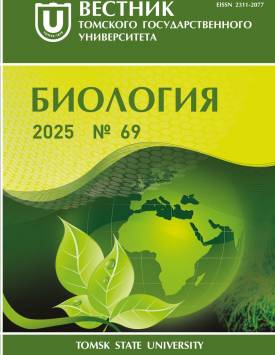On the expansion of the ecological niche of the hollow malaria mosquito Anopheles plumbeus Stephens, 1828 in Russia and Belarus
The malaria mosquito, Anopheles plumbeus Stephens, 1828, is the only species in Europa, capable of transmitting the pathogen of the most deadly tropical malaria. Until recently, it was considered a species that rarely attacks humans, is confined to broadleaved forests and does not form high-density populations. The aim of the present work was to study changes in the ecological preferences and geographical distribution ofAn. plumbeus in Russia and Belarus. Our team studied breeding sites and collected An. plumbeus in natural and anthropogenic habitats between 2017 and 2024. Species affiliation was determined by morphological parameters, using standard keys. A part of randomly selected individuals from each sample was subjected to molecular genetic analysis. We obtained fragments of ITS2 ribosomal DNA sequence and BOLD-fragments of mitochondrial gene coxl. We developed primers for molecular genetic identification of An. plumbeus using the Primer3 programme (https://primer3.ut.ee/). ITS2 sequence fragments of An. plumbeus ribosomal DNA were obtained from primers of 5,8S (5'-TGTGAACTGCAGGACACAT-3') and 28S (5'-ATGCTTAAATTTAGGGGGTA-3'). BOLD fragments of the mitochondrial cox1 gene of An. plumbeus were obtained using our designed primers An.pl_F (5'-TTTCAACAAA TCATAAGGATATTGG-3') and An.pl_R (5'-TATACTTCTGGGTGTCCAAAA AATCA-3'). Until 2019, we found An. plumbeus larvae only in natural brood sites such as fallen large leaves, old stumps, forks and tree hollows. Starting from 2019, we started to find An. plumbeus larvae in urbanized areas. The number of detected brood sites in anthropogenic habitats increased from year to year: in 2019, 1; 2020, 6; 2021, 14. - 6; 2021 - 14; 2024 - 50. Some populations of An. plumbeus have retained their predilection for laying eggs in tree hollows in urban parks and alleys. Other populations in urbanised areas began to lay eggs only in containers of anthropogenic origin. In 2024, as a result of an expedition, we confirmed the presence of An. plumbeus in the Republic of Belarus. An. plumbeus larvae were found in a car tyre in the city park in Mogilev on the border of broad-leaved forest.Together with changes in preferences for choosing egglaying sites, we observe changes in behavioural preferences for selecting a feeder. In 2020 and 2021, we captured 2 and 4 adults of An. plumbeus on our own during 30 minutes of counting, respectively. All captured adults swarmed without attack. In a similar survey in 2024, we captured 8 adults, including 5 attacking females and 3 males. We believe that the observed transition to synanthropic existence of An. plumbeus mosquitoes may be a prerequisite for the formation of potentially invasive populations in the future. By transitioning to synanthropic existence, the population gets rid of a number of biotopic constraints that determine its range. Previously, the range of An. plumbeus was highly fragmented due to its attachment to humid broadleaved forests. The limited number of larval habitats, low humidity and seasonal irregularity of precipitation may have acted as factors limiting the population size of this species. The large number of potential breeding sites for An. plumbeus clutches, high humidity in many areas where irrigation systems are developed, and the presence of a large number of people as potential feeders are present in urbanised environments. Synanthropisation has allowed the species to expand its ecological niche, spread beyond its native range, which was previously restricted to broadleaved forests, and greatly increase its numbers. The observed transformation of the ecological niche of An. plumbeus is similar to the changes that occurred in a number of mosquito species of the genus Aedes of the subgenus Stegomyia. We believe that synanthropization involves a sustained change in biotopic preferences that presumably has a genetic basis. The data obtained on the ecological preferences of An. plumbeus require reconsideration of the status of the species as a potential vector of tropical malaria and attention of anti-epidemiological services to this species. The Authors declare no conflict of interest.
Keywords
synanthropization, ecological niches, Anopheles plumbeus, ITS2, cox1, range, malaria vectorsAuthors
| Name | Organization | |
| Bega Anna G. | Federal State University of Education; Vavilov Institute of General Genetics, Russian Academy of Sciences | anni.miya@gmail.com |
| Loginov Denis N. | Scientific and Practical Centre of the National Academy of Sciences of Belarus on Bioresources | kavax@yandex.by |
| Gordeev Mikhail I. | Federal State University of Education; Vernadsky Russian State University of National Economy | gordeev_mikhail@mail.ru |
| Goryacheva Irina I. | Federal State University of Education; Vavilov Institute of General Genetics, Russian Academy of Sciences | iigoryacheva@mail.ru |
| Borodin Lev S. | Federal State University of Education | lev.borodin2016@yandex.ru |
| Lee Elizaveta Y. | Federal State University of Education | lilizavetau@mail.ru |
| Moskaev Anton V. | Federal State University of Education; Vernadsky Russian State University of National Economy | anton-moskaev@yandex.ru |
References

On the expansion of the ecological niche of the hollow malaria mosquito Anopheles plumbeus Stephens, 1828 in Russia and Belarus | Vestnik Tomskogo gosudarstvennogo universiteta. Biologiya - Tomsk State University Journal of Biology. 2025. № 69. DOI: 10.17223/19988591/69/2
